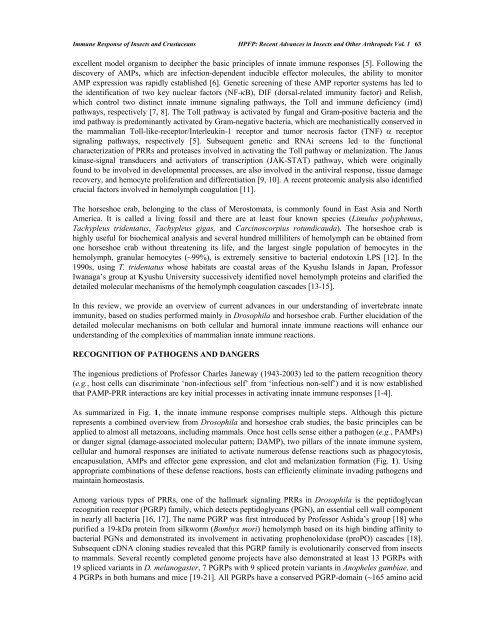chapter 1 - Bentham Science
chapter 1 - Bentham Science
chapter 1 - Bentham Science
Create successful ePaper yourself
Turn your PDF publications into a flip-book with our unique Google optimized e-Paper software.
Immune Response of Insects and Crustaceans HPFP: Recent Advances in Insects and Other Arthropods Vol. 1 63<br />
excellent model organism to decipher the basic principles of innate immune responses [5]. Following the<br />
discovery of AMPs, which are infection-dependent inducible effector molecules, the ability to monitor<br />
AMP expression was rapidly established [6]. Genetic screening of these AMP reporter systems has led to<br />
the identification of two key nuclear factors (NF-B), DIF (dorsal-related immunity factor) and Relish,<br />
which control two distinct innate immune signaling pathways, the Toll and immune deficiency (imd)<br />
pathways, respectively [7, 8]. The Toll pathway is activated by fungal and Gram-positive bacteria and the<br />
imd pathway is predominantly activated by Gram-negative bacteria, which are mechanistically conserved in<br />
the mammalian Toll-like-receptor/Interleukin-1 receptor and tumor necrosis factor (TNF) receptor<br />
signaling pathways, respectively [5]. Subsequent genetic and RNAi screens led to the functional<br />
characterization of PRRs and proteases involved in activating the Toll pathway or melanization. The Janus<br />
kinase-signal transducers and activators of transcription (JAK-STAT) pathway, which were originally<br />
found to be involved in developmental processes, are also involved in the antiviral response, tissue damage<br />
recovery, and hemocyte proliferation and differentiation [9, 10]. A recent proteomic analysis also identified<br />
crucial factors involved in hemolymph coagulation [11].<br />
The horseshoe crab, belonging to the class of Merostomata, is commonly found in East Asia and North<br />
America. It is called a living fossil and there are at least four known species (Limulus polyphemus,<br />
Tachypleus tridentatus, Tachypleus gigas, and Carcinoscorpius rotundicauda). The horseshoe crab is<br />
highly useful for biochemical analysis and several hundred milliliters of hemolymph can be obtained from<br />
one horseshoe crab without threatening its life, and the largest single population of hemocytes in the<br />
hemolymph, granular hemocytes (~99%), is extremely sensitive to bacterial endotoxin LPS [12]. In the<br />
1990s, using T. tridentatus whose habitats are coastal areas of the Kyushu Islands in Japan, Professor<br />
Iwanaga’s group at Kyushu University successively identified novel hemolymph proteins and clarified the<br />
detailed molecular mechanisms of the hemolymph coagulation cascades [13-15].<br />
In this review, we provide an overview of current advances in our understanding of invertebrate innate<br />
immunity, based on studies performed mainly in Drosophila and horseshoe crab. Further elucidation of the<br />
detailed molecular mechanisms on both cellular and humoral innate immune reactions will enhance our<br />
understanding of the complexities of mammalian innate immune reactions.<br />
RECOGNITION OF PATHOGENS AND DANGERS<br />
The ingenious predictions of Professor Charles Janeway (1943-2003) led to the pattern recognition theory<br />
(e.g., host cells can discriminate ‘non-infectious self’ from ‘infectious non-self’) and it is now established<br />
that PAMP-PRR interactions are key initial processes in activating innate immune responses [1-4].<br />
As summarized in Fig. 1, the innate immune response comprises multiple steps. Although this picture<br />
represents a combined overview from Drosophila and horseshoe crab studies, the basic principles can be<br />
applied to almost all metazoans, including mammals. Once host cells sense either a pathogen (e.g., PAMPs)<br />
or danger signal (damage-associated molecular pattern; DAMP), two pillars of the innate immune system,<br />
cellular and humoral responses are initiated to activate numerous defense reactions such as phagocytosis,<br />
encapusulation, AMPs and effector gene expression, and clot and melanization formation (Fig. 1). Using<br />
appropriate combinations of these defense reactions, hosts can efficiently eliminate invading pathogens and<br />
maintain homeostasis.<br />
Among various types of PRRs, one of the hallmark signaling PRRs in Drosophila is the peptidoglycan<br />
recognition receptor (PGRP) family, which detects peptidoglycans (PGN), an essential cell wall component<br />
in nearly all bacteria [16, 17]. The name PGRP was first introduced by Professor Ashida’s group [18] who<br />
purified a 19-kDa protein from silkworm (Bombyx mori) hemolymph based on its high binding affinity to<br />
bacterial PGNs and demonstrated its involvement in activating prophenoloxidase (proPO) cascades [18].<br />
Subsequent cDNA cloning studies revealed that this PGRP family is evolutionarily conserved from insects<br />
to mammals. Several recently completed genome projects have also demonstrated at least 13 PGRPs with<br />
19 spliced variants in D. melanogaster, 7 PGRPs with 9 spliced protein variants in Anopheles gambiae, and<br />
4 PGRPs in both humans and mice [19-21]. All PGRPs have a conserved PGRP-domain (~165 amino acid

















